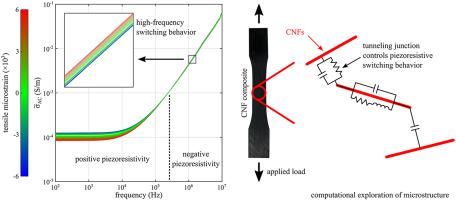Our official English website, www.x-mol.net, welcomes your
feedback! (Note: you will need to create a separate account there.)
Frequency-Dependent Alternating Current Piezoresistive Switching Behavior in Self-Sensing Carbon Nanofiber Composites
Carbon ( IF 10.5 ) Pub Date : 2021-03-01 , DOI: 10.1016/j.carbon.2020.11.018 G.M. Koo , T.N. Tallman
Carbon ( IF 10.5 ) Pub Date : 2021-03-01 , DOI: 10.1016/j.carbon.2020.11.018 G.M. Koo , T.N. Tallman

|
Abstract Carbon nanofillers have received much attention for piezoresistive-based self-sensing of deformation in polymeric, cementitious, and ceramic composites. To date, direct current (DC) conductivity has been overwhelmingly favored for self-sensing. This is important because alternating current (AC) methods, though much less studied, have advantages over DC methods. Therefore, we herein explore AC conductivity-strain relations for polymeric carbon nanofiber (CNF) composites. It was found that Jonscher’s power law accurately describes AC conductivity as a function of both normal and shear strain. This provides a framework by which macroscale AC piezoresistivity can be characterized. Further, it was observed that the coefficients of this power law are non-linear in strain. During this testing, it was also observed that the CNF/epoxy exhibits a frequency-dependent piezoresistive switching behavior. At low frequencies, the material exhibits positive piezoresistivity. At higher frequencies, however, the material exhibits negative piezoresistivity. A state of zero piezoresistivity also exists between these cases. Computational micro-modeling revealed that this piezoresistive switching behavior is the consequence of inter-CNF AC transport behaving like a parallel resistor-capacitor arrangement and strain affecting the parallel or tunneling resistance. This novel switching behavior opens the door to many exciting possibilities for frequency-selective piezoresistive behavior in next-generation carbon nanofiller-based sensors.
中文翻译:

自感碳纳米纤维复合材料中的频率相关交流压阻开关行为
摘要 碳纳米填料在聚合物、水泥和陶瓷复合材料中基于压阻的变形自感知受到了广泛关注。迄今为止,直流 (DC) 电导率已被压倒性地用于自感应。这很重要,因为交流 (AC) 方法虽然研究较少,但比直流方法具有优势。因此,我们在此探索聚合碳纳米纤维 (CNF) 复合材料的 AC 电导率-应变关系。发现 Jonscher 的幂律准确地将交流电导率描述为法向应变和剪切应变的函数。这提供了一个框架,通过该框架可以表征宏观交流压阻。此外,观察到该幂律的系数在应变方面是非线性的。在这次测试中,还观察到 CNF/环氧树脂表现出与频率相关的压阻开关行为。在低频下,材料表现出正压阻性。然而,在较高频率下,材料表现出负压阻。在这些情况之间也存在零压阻状态。计算微建模表明,这种压阻开关行为是 CNF 间交流传输行为类似于并联电阻器 - 电容器布置和影响并联或隧道电阻的应变的结果。这种新颖的开关行为为下一代碳纳米填料传感器中频率选择性压阻行为的许多令人兴奋的可能性打开了大门。该材料表现出正压阻性。然而,在较高频率下,材料表现出负压阻。在这些情况之间也存在零压阻状态。计算微建模表明,这种压阻开关行为是 CNF 间交流传输行为类似于并联电阻器 - 电容器布置和影响并联或隧道电阻的应变的结果。这种新颖的开关行为为下一代碳纳米填料传感器中频率选择性压阻行为的许多令人兴奋的可能性打开了大门。该材料表现出正压阻性。然而,在较高频率下,材料表现出负压阻。在这些情况之间也存在零压阻状态。计算微建模表明,这种压阻开关行为是 CNF 间交流传输行为类似于并联电阻器 - 电容器布置和影响并联或隧道电阻的应变的结果。这种新颖的开关行为为下一代碳纳米填料传感器中频率选择性压阻行为的许多令人兴奋的可能性打开了大门。计算微建模表明,这种压阻开关行为是 CNF 间交流传输行为类似于并联电阻器 - 电容器布置和影响并联或隧道电阻的应变的结果。这种新颖的开关行为为下一代碳纳米填料传感器中频率选择性压阻行为的许多令人兴奋的可能性打开了大门。计算微建模表明,这种压阻开关行为是 CNF 间交流传输行为类似于并联电阻器 - 电容器布置和影响并联或隧道电阻的应变的结果。这种新颖的开关行为为下一代碳纳米填料传感器中频率选择性压阻行为的许多令人兴奋的可能性打开了大门。
更新日期:2021-03-01
中文翻译:

自感碳纳米纤维复合材料中的频率相关交流压阻开关行为
摘要 碳纳米填料在聚合物、水泥和陶瓷复合材料中基于压阻的变形自感知受到了广泛关注。迄今为止,直流 (DC) 电导率已被压倒性地用于自感应。这很重要,因为交流 (AC) 方法虽然研究较少,但比直流方法具有优势。因此,我们在此探索聚合碳纳米纤维 (CNF) 复合材料的 AC 电导率-应变关系。发现 Jonscher 的幂律准确地将交流电导率描述为法向应变和剪切应变的函数。这提供了一个框架,通过该框架可以表征宏观交流压阻。此外,观察到该幂律的系数在应变方面是非线性的。在这次测试中,还观察到 CNF/环氧树脂表现出与频率相关的压阻开关行为。在低频下,材料表现出正压阻性。然而,在较高频率下,材料表现出负压阻。在这些情况之间也存在零压阻状态。计算微建模表明,这种压阻开关行为是 CNF 间交流传输行为类似于并联电阻器 - 电容器布置和影响并联或隧道电阻的应变的结果。这种新颖的开关行为为下一代碳纳米填料传感器中频率选择性压阻行为的许多令人兴奋的可能性打开了大门。该材料表现出正压阻性。然而,在较高频率下,材料表现出负压阻。在这些情况之间也存在零压阻状态。计算微建模表明,这种压阻开关行为是 CNF 间交流传输行为类似于并联电阻器 - 电容器布置和影响并联或隧道电阻的应变的结果。这种新颖的开关行为为下一代碳纳米填料传感器中频率选择性压阻行为的许多令人兴奋的可能性打开了大门。该材料表现出正压阻性。然而,在较高频率下,材料表现出负压阻。在这些情况之间也存在零压阻状态。计算微建模表明,这种压阻开关行为是 CNF 间交流传输行为类似于并联电阻器 - 电容器布置和影响并联或隧道电阻的应变的结果。这种新颖的开关行为为下一代碳纳米填料传感器中频率选择性压阻行为的许多令人兴奋的可能性打开了大门。计算微建模表明,这种压阻开关行为是 CNF 间交流传输行为类似于并联电阻器 - 电容器布置和影响并联或隧道电阻的应变的结果。这种新颖的开关行为为下一代碳纳米填料传感器中频率选择性压阻行为的许多令人兴奋的可能性打开了大门。计算微建模表明,这种压阻开关行为是 CNF 间交流传输行为类似于并联电阻器 - 电容器布置和影响并联或隧道电阻的应变的结果。这种新颖的开关行为为下一代碳纳米填料传感器中频率选择性压阻行为的许多令人兴奋的可能性打开了大门。











































 京公网安备 11010802027423号
京公网安备 11010802027423号